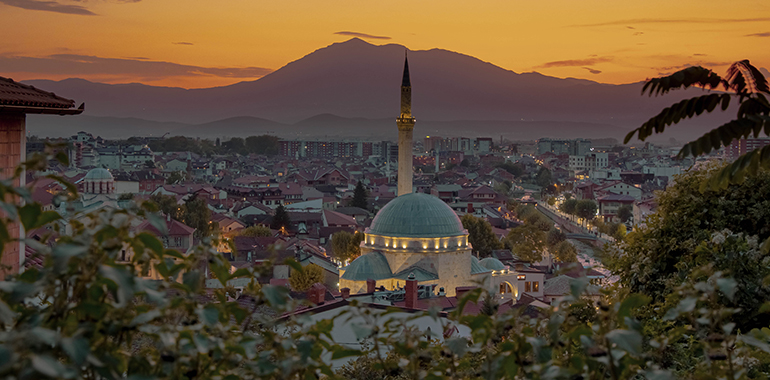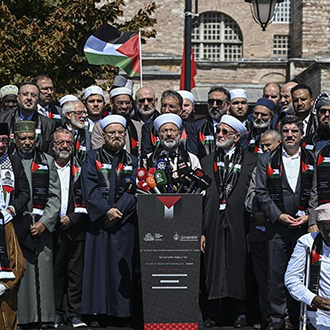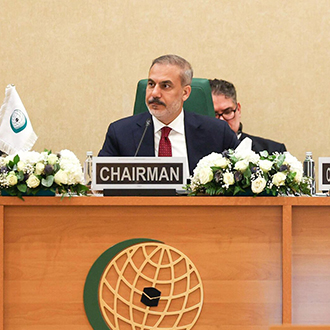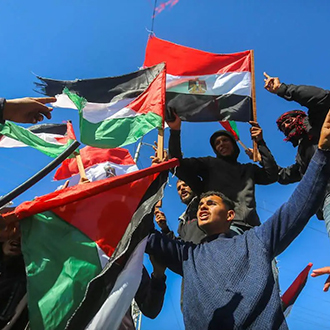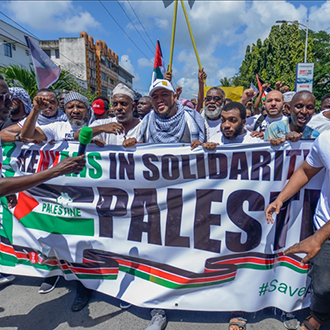On the other hand, major powers like Rome and Byzantium, which ruled over this region for centuries, also exerted influence in matters of religion and faith, striving for the spread of their religions. Following the Edict of Milan (Constantinian era) in 313 AD, which granted freedom of religion, and subsequently its recognition as the official religion of the Roman State in 380 AD (during the reign of Theodosius the Great), Christianity began to spread rapidly in the regions under Roman dominion. As a result of dogmatic disagreements between Christian clergy and factions, the Roman Empire, which had split into Eastern and Western halves in 395 AD, intensified its influence over the Balkans. Consequently, the Balkans became a region where the borders of these two empires intersected and their spheres of influence competed. Consequently, the Western Roman Empire maintained its influence in cities along the western coast of the Balkans, such as Durres and Shkoder, while the Byzantine Empire established its dominion in the southern, inland, and eastern regions. These political developments and migrations also had a significant impact on the religious landscape of the region.
In the areas under the control of the Western Roman Empire, efforts were made to propagate Western Christianity, namely the Catholic Church, while in the regions dominated by the Byzantine Empire, the Eastern Church, or Orthodoxy, spread. Thus, until the Ottoman era, the Catholic and Orthodox churches remained influential central institutions as the official religions of the two empires in the Balkans. In the region encompassing present-day Kosovo, the vast majority of the indigenous population and nearly all of the Slavic migrants had adopted Christianity as their religion during that era.
With the arrival of the Ottomans in the Balkans, the vast majority of the Kosovar population embraced Islam as their religion. Indeed, the overwhelming majority of Croats in the Balkans, along with a small segment of Albanians, adhere to Catholicism. Meanwhile, Eastern Orthodoxy has taken root among populations like Greeks, Serbs, and Bulgarians. Conversely, the majority of Bosniaks and Albanians have embraced Islamic teachings, and these diverse communities have coexisted in the region for centuries. It is also known that Jews lived in Kosovo during the Ottoman period.
As is the case in many parts of the world, present-day Kosovo is home to a diverse array of religious communities, each striving to maintain its presence. In addition to the major religious communities of Muslims, Catholics, Orthodox Christians, Protestants, and Jews, there are also many smaller and distinct religious groups operating in Kosovo. According to the official census conducted in 2011, the population of Kosovo comprises 95% Muslims, 2% Orthodox Christians, 1% Catholics, and 2% adherents of other religions and beliefs. Muslims in Kosovo are primarily composed of individuals from Albanian, Turkish, Bosniak, and Romanian ethnic backgrounds. Catholics are predominantly of Albanian ethnicity, while Orthodox Christians are primarily Serbs and Montenegrins. Although Muslims are the majority in Kosovo, their influence today is less than that of other religions. Especially in the political arena, Muslims remain in the background. Adherents of other faiths enjoy certain privileges. Following the recent war, Christians have been brought to the forefront, partly due to the influence of various organizations from the Western world.
History and administrative structure of the Kosovo Islamic Union
According to the Constitution of the Republic of Kosovo, Kosovo is a secular state and is neutral in matters of religion and conscience. It states that no religious group shall be granted privileges or subjected to discrimination. According to the constitution, religious communities are free to independently regulate their internal organization and conduct religious activities and ceremonies.
Established in 1948 and recognized as the sole authority on Islam by the United Nations Mission in Kosovo (UNMIK), the Kosovo Islamic Union (KIU) is an autonomous institution that operates independently from the state in providing religious services.
It is reasonable to acknowledge that the establishment of Islamic life and institutions in Kosovo began with the region’s incorporation into the Ottoman Empire.
During the Ottoman era, as was the case in other regions under the authority of the Ottoman Empire, the religious affairs of Muslims in Kosovo were administered by regional muftiships affiliated with the Sheikh al-Islam in Istanbul. The withdrawal of the Ottoman Empire from Kosovo left Kosovar Muslims without spiritual leadership, and an unfavorable social and political situation emerged in the regions that fell under Slavic occupation.
The administrative institutions of the Islamic Religious Community began to be established in 1919, under the orders of the Ministry of Religious Affairs, during the Kingdom of Serbs, Croats, and Slovenes. According to the circular, a Muslim community could be formed in a settlement if there were at least 100 Muslim households in the village or neighborhood.
In 1920, there were 14 regional muftiships in Kosovo, with the main muftiate located in Pristina. During this period, the institutional organization of Muslims was divided into two. Muslims in Bosnia, Croatia, and Slovenia were affiliated with the Ra’is al-Ulema, headquartered in Sarajevo, while Muslims in Kosovo, Macedonia, Serbia, and Montenegro were affiliated with the Grand Mufti, headquartered in Belgrade.
After the establishment of the Kingdom of Yugoslavia on January 6, 1929, there was a change in the Islamic Religious Community. Until that time, the institutions affiliated with the former Grand Muftiate, which was headquartered in Belgrade, were connected to the newly established Majlis al-Ulama in Skopje, including Kosovo.
During the years 1941- 1944, the Islamic Religious Community in Kosovo was affiliated with the Muslim Community headquartered in Tirana, along with the Chief Muftis of Prizren and Pristina.
With the conclusion of World War II, Kosovo was separated from Albania and placed under the dominion of Yugoslavia. This political separation also triggered a religious divide. The headquarters of the Kosovo Islamic Religious Community, which had been affiliated with Albania until that time, had to be relocated from Tirana to Sarajevo. Consequently, from 1945 to 1990, it was affiliated with the Religious Union of the Yugoslav Federation, headquartered in Sarajevo.
The early 1990s marked a new era of significant transformations for the people of Kosovo. The revocation of Kosovo’s autonomy by Slobodan Milosevic during the Yugoslav era triggered widespread outrage among Albanians and ignited their efforts for secession from Serbia. During this period, on July 2, 1990, the Kosovar regional assembly declared Kosovo’s independence. The religious sphere mirrored the separation efforts initiated in the political arena, and on December 11, 1993, the Kosovo Islamic Union Assembly declared its independence, breaking away from the previous presidency. Thus, a new era dawned for the Kosovo Islamic Union.
Today, the Kosovo Islamic Union is an independent institution serving the Muslim communities of Kosovo, including those residing in the Preševo Valley within Serbia’s borders, as well as the Kosovar diaspora living abroad. The Kosovo Islamic Union has its headquarters in Pristina and possesses its own unique symbols, flag, emblem, and seal. The Kosovo Islamic Union’s mission is to plan, organize, coordinate, supervise, and ensure the implementation of religious life in the region. Through its organs and institutions, the Union is tasked with ensuring that Muslims live in accordance with Islamic principles, preserving Islamic religious consciousness, and promoting the social, economic, scientific, cultural, and spiritual development of Muslims. To further advance its mission, KIU has established within its structure educational institutions such as the Hafiz Institute (institute for Qur’an memorization), madrasah, and the Faculty of Islamic Sciences.
The Faculty of Islamic Sciences, madrasahs, and other institutions have autonomy in educational, academic, administrative, and financial matters and are governed by individuals appointed by the Presidency of the Islamic Union. The monitoring of operations and the expenses of the institutions are covered through the Islamic Union, the Islamic Union Councils, and the Bayt al-Mal.
The structure of the organs of the Islamic Union of the Republic of Kosovo is established within the framework of its constitution, drafted in 1947, and subsequently restructured and finalized in 1949. The aforementioned constitution has undergone amendments over the years. The constitution currently in effect is the one that was finalized with some amendments made at the meeting of the Kosovo Islamic Union Assembly in September 2013. Accordingly, the structure of the Islamic Union operating in Kosovo consists of the Congregation Council (in each mosque), the Local Islamic Union Council (municipal muftiates), the Islamic Union Assembly (in the center), and the Islamic Union Presidency (center).
The Kosovo Islamic Union is divided into eight regions. Seven of these regions are located in Kosovo (Pristina, Gjilani, Mitrovica, Prizren, Peja, Ferizaj, and Gjakova), while the other is located in the Preševo Valley (Albanian Presevo, Bujanovac, and Medveda). Within each region, there are the councils of the Islamic Union operating in that region. The Islamic Union’s councils are composed of the following regional councils: Pristina Region: Pristina, Podujevo, Lipjan, Gllogoc (Drenas), Fushe Kosova, and Obilic; Gjilani Region: Gjilani, Kamenica, and Viti; Mitrovica Region: Mitrovica, Vushtrri, and Skenderaj; Prizren Region: Prizren, Dragash, Suhareka, and Gora; Peja Region: Peja, Istog, Deçan, and Klina; Ferizaj Region: Ferizaj, Kaçanik, Hani i Elezit, and Shtime; Gjakova Region: Gjakova, Rahovec, and Malisheva; Preševo Region: Preševo, Bujanovac, and Medveđa.
The establishment of close ties between the Kosovo Islamic Union, the Presidency of Religious Affairs of Türkiye, and the Türkiye Diyanet Foundation has revitalized the centuries-old customs, traditions, and historical ties of Muslims in Kosovo.
The Islamic Union of the Republic of Kosovo, which has adopted the task of contributing to the social, economic, scientific, cultural, and spiritual development of the Kosovar Muslims, continues to strengthen its administrative structure and bodies day by day and continues to serve both in its central organization and regional boards, as well as in its affiliated units and institutions. Through its mosques, schools, madrasahs, Faculty of Islamic Sciences, and hafiz institutions, the Islamic Union of the Republic of Kosovo contributes to equipping Muslims with religious education, transmitting traditional Islamic teachings that align with the fabric of society, and fostering an authentic understanding of Islam.



